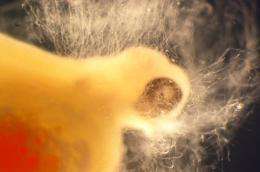New findings about Saprolegnia infections in Norwegian salmon hatcheries

Infections caused by oomycetes (or water moulds) of the Saprolegnia family reappeared as a loss factor in the fish farming industry after the dye malachite green was prohibited for use as a water treatment agent.
New findings about the distribution, infection potential and risk factors linked to this fungus are therefore necessary in order to combat Saprolegnia infections effectively. Even Thoen's doctoral research has uncovered new knowledge about Saprolegnia in Norway which will make it possible to provide the industry with new advice on measures to prevent and combat the problem.
In Norway, Saprolegnia infections have usually been detected in fish eggs, but they can occur throughout the whole freshwater development phase. Brood stock released into freshwater before egg stripping are moreover especially susceptible due to the immune suppression that occurs during sexual maturation. In fish farming industries in other countries, losses caused by Saprolegnia seem to be considerable in the later stages of the freshwater development phase as well. A collaborative project between The Norwegian Veterinary Institute and The Norwegian School of Veterinary Science financed by The Research Council of Norway has provided new information about the spread of Saprolegnia infections, infection potential and risk factors.
Method of research
The aim of the project was to gain an overview of the prevalence and composition of species of Saprolegnia in Norwegian salmon hatcheries, identify risk factors and propose measures for preventing and combating infection. Saprolegnia reproduces, spreads and infects by means of spores. Estimating the concentration of spores in the water systems of hatcheries was therefore necessary before further work could be undertaken.
Isolating and quantifying spores in water can only be achieved by using a reliable method. The first step was therefore to establish and validate a method that was both practicable and adequately sensitive. The method chosen is based on cultivation in microtitre plates and makes it possible to quantify spores in water sources. This method can also be used to evaluate how different treatment agents affect the number of spores.
Saprolegnia is prevalent
In carrying out his doctoral research project, Even Thoen collected and analysed Saprolegnia in water samples from 26 salmon hatcheries along the Norwegian coast, from Agder in the south to Finnmark in the north. The analyses show that the water in all the hatcheries in the study is affected by Saprolegnia, but that the degree of concentration varied greatly from plant to plant. Furthermore, it was revealed that the spores propagate significantly in the pipe systems, hatcheries and tanks of the plants, even though infection is not detectable on the eggs or fish. It follows that there is a high risk of infection in many hatcheries if other necessary conditions are present.
9 isolates were characterised belonging to 5 different species of Saprolegnia. This constitutes fewer species than the number detected in natural water sources in studies carried out in other European countries. One possible explanation for this is that some species adjust to the environmental conditions in pipe and tank systems better than others and therefore eradicate less adaptive species.
This corresponds with the finding that a large proportion (79%) of the characterised isolates proved to be Saprolegnia diclina (subclade III). This type is regarded primarily as a saprophyte (an organism that lives on dead organic matter), but during infection experiments, one isolate from this group proved to be the most efficient at infecting fish eggs. Other species discovered were S. parasitica, S. ferax, S. hypogyna and Scoliolegnia sp.
Infection experiments
Infection experiments on eggs were carried out with 8 selected isolates and 3 different infection models. The aim was to uncover the risk factors of infection on eggs and to find out whether there are differences between the isolates' ability to infect. The results of these experiments indicate that Saprolegnia spores are not capable of infecting living eggs, but that dead eggs are well suited as substrates.
However, fungal hyphae growing from infected, dead eggs were shown to be capable of penetrating and killing living eggs. The study also revealed that only limited contact with Saprolegnia hyphae was necessary in order to harm the eggs so that they died shortly afterwards. These findings demonstrate that dead eggs and organic material not only increase the risk of infection but are also an essential precondition for the development of Saprolegnia infection on eggs in hatcheries. This underlines the importance of frequently removing such material in order to prevent infection spreading to live eggs.
During the course of the project, an infection model for Saprolegnia on eggs was developed which will be useful both in studies of pathogenesis/virulence (disease development) and for tests on drugs to combat Saprolegnia fungal infections.
Even Thoen defended his doctoral thesis at The Norwegian School of Veterinary Science on 6th December 2011. His thesis is entitled: “Saprolegnia infections in Norwegian salmon hatcheries - occurrence, characteristics and pathogenicity.”
Provided by Norwegian School of Veterinary Science




















